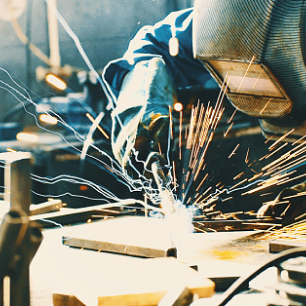Welding Digest
Jump to:
Cobots Help Bridge the Welding Skills Gap
90%. That’s the placement rate for graduates of the Industrial Arts Institute (IAI) (iaiworks.com), a welding and fabrication trade school and nonprofit organization based in Onaway, Mich. To further enhance its training, the school has incorporated collaborative robots (cobots) into its welding curriculum since 2022.
Cobot welding systems are helping thousands of welders around the world every day. Cobots are easy-to-use tools that boost welder productivity and improve ergonomics by handling the most repetitive welding jobs, leaving skilled, hard-to-staff welders free to focus on other tasks.
Cobots also provide a useful way to change outdated narratives around careers in manufacturing. Visions of welding as a highly repetitive, hazardous, and demanding job have no place in the ergonomic, high-tech world of welding-cobot collaboration.
Since cobots are designed to be safely deployed around humans, following a thorough risk assessment, they offer a low-stress, safe way for students of all skill levels to learn how to automate welding processes.
The Opportunities in Automation
Providing educational opportunities and resources is at the forefront of industry’s response to the welding labor gap. This means strategic collaboration between welding robot original equipment manufacturers, industry partners, employers, and educational institutions, from high schools and trade schools to workforce development centers and universities.
According to Tamara Ward, executive director of IAI, collaborative robot systems are revolutionizing the welding and fabrication industry. “We advise our students that ignoring automation means missing out on advanced technology,” she said.
In 2022, the IAI created an educational initiative with Red-D-Arc and Airgas to incorporate the BotX™ cobot welding system into its welding training program. Since then, 83 cobot-trained students have graduated, with nine more graduating in 2025. IAI graduates can expect to pick up an entry-level welding role with a starting salary of between $50,000 and $80,000.
“The IAI has a 90% placement rate in industry because our program is a little different. We prepare our students for industry,” Ward said. “They don’t just learn welding and fabrication theory; they’re exposed to the type of technology that they will see in the workplace, like cobots.”
Usability and safety make collaborative welding systems a great fit for educational environments, Ward noted.
“We tell our students that cobots are another tool in the welder’s toolbox of skills. In our industry, you’re considered elite if you’re able to operate any type of welding automation, and you often see premier wages,” Ward said, adding that she has seen companies with cobots sitting idle once the cobot operator moves on, prompting companies to proactively search for cobot welding talent. “We often have scenarios where our students are targeted by industry because they can operate and understand collaborative automation,” she explained.
Meanwhile, students embrace their hands-on sessions with collaborative welding automation.
“I really enjoyed using the BotX. It was super easy and had some cool features,” said Dakota Sandefur, a welding and fabrication student at the IAI. “Having knowledge and skills in programming and operating a collaborative robot is another tool that I will add to my toolbox as I start my career as a welder and fabricator.”
Cobot Welding Connects Training with Real-World Applications
Nathan Vander Wert, a welding instructor at Des Moines Area Community College (DMACC) in Iowa, asserts collaboration with employers is key to providing the right training for the right market.
“Two times a year, in the fall and springtime, we meet with employers from around the area, and they tell us where things are at with them and the type of skills they’re looking for,” he said, explaining that in 2023, employers expressed a desire for students to be exposed to automated welding. “We started a collaboration with Vectis Automation, and we are now incorporating cobots into our training programs.”
About 95% of graduates from DMACC’s welding programs find employment within six months. For Vander Wert, part of the appeal of cobots is that they can be used as an educational platform to teach a wide range of applications.
“Beyond the standard benefits of practical welding, cobots can be used to demonstrate welding principles and welding inspection tasks. We’ve seen students do better because they’re able to see the cobot weld an actual part in real time. It helps them tremendously,” Vander Wert explained.
A welder by trade, Vander Wert appreciates the intuitive hand-guiding programming methods and user-friendly interfaces that cobots provide.
“Usability is a big factor with cobots,” he said. “I’m not a trained programmer, but training on a cobot was pretty simple; just about anybody could figure it out as it’s not that different from using a smartphone app. I find hand-guiding in freedrive mode really intuitive, especially after welding for so many years. And you can do the fine adjusting with just a quick touch of the parameters in the software.”
Cobots can even help people overcome their fears and hesitation around welding automation.
“Once students see the cobot in action, it changes their mind about automation,” he said. “Cobots don’t fit into the intimidating stereotype of a traditional robot. Plus, the majority of welders are visual and hands-on learners, so seeing the cobot in real time is a really good teaching aid.”
Attracting Young Talent
Josh Pawley, vice president of business development and cofounder of Vectis Automation, said cobot welding solutions help attract young people to manufacturing careers.
“I had someone say to me, ‘Hey, it’s like I’m playing a PlayStation, and it just happens to make welds,’” he recalled. “The younger generation may be less interested in welding 1000 brackets a day, but using a cobot to weld 1000 brackets is an exciting challenge that embraces modern technology. The ability to use automation in such ways is enticing to the type of younger demographic that the manufacturing and welding sectors are working hard to attract.”
In addition to providing welding cobots to dozens of brick-and-mortar educational institutions, Vectis Automation also offers online, module-based video training on everything from setting up a cobot welding system to handling advanced features through its Training Academy.
“This provides a way for customers to quickly, easily, and cost-effectively train cobot champions and even second and third shifts without having to fly somebody out to training,” Pawley said, explaining that while in-person training has its place, online resources provide a “permanent, always available DIY training option.”
The Vectis Training Academy includes modules on creating weld patterns, performing stitch welds, tracking joints, and using touch sensing, among many other topics.
“We’ve got more than 650 customers, and nearly all of them are using our online training modules. Many of them have trained multiple cobot champions with it, and the feedback is always, ‘Wow! This is great.’”
Conclusion
As cobot technology becomes integral to welding programs, it enhances both training and student employability. By embracing automation, educational institutions are equipping the next generation of welders with the skills needed to thrive in an evolving industry.
This article was written by Stephanie Kobayashi (global education manager at Universal Robots) for the American Welding Society.


